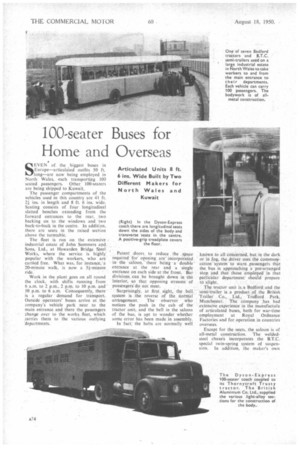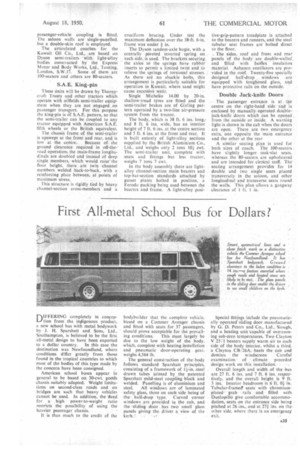100-seater Buses for Home and Overseas
Page 44

Page 45

If you've noticed an error in this article please click here to report it so we can fix it.
Articulated Units 8 ft. 6 ins. Wide Built by Two Different Makers for North Wales and Kuwait
SEVEN of the biggest buses in Europe—articulated outfits 50 ft. long—are now being employed in North Wales, each transporting 100 seated passengers. Other 100-seaters are being shipped to Kuwait.
The passenger compartments of the vehicles used in this country are 41 ft. 21 ins, in length and 8 ft. 6 ins. wide. Seating consists of four longitudinal slatted benches extending from the forward entrances to the rear, two backing on to the windows and two back-to-back in the centre. In addition, there are seats in the raised section above the turntable.
The fleet is run on the extensive , industrial estate of John Summers andSons, Ltd., at Hawarden Bridge Steel. Works, where the service is highly popular with the workers, who are carried free. What was, for instance,`a 20-minute walk, is now a *minute ride.'
Work in the plant goes on all round the clock, with shifts running from 6 a.m. to 2 p.m., 2 p.m. to 10 p.m. and 10 p.m. to 6 a.m. Consequently, there is a regular demand for transport. Outside operators' buses arrive at the company's vehicle park near to the main entrance and there the passengers change over to the works fleet, which earties them to the various outlying departments.
Patent doors to reduce the space required. for oPening. are incorporat'ed inthe saloon. there being a double 'entrance at the rear and a single entrance on each side at the front. Bar divisions can . be brought down in -the interior, so that opposing streams of passengers do. not meet.
Surprisingly, at first sight, the bell, system is the reverse of the normal arrangement. The observer Who notices the push in the cab of the tractor unit, and the bell in the saloon of the bus, is apt to wonder whether some error has been made in assembly.
In fact: the halts are normally well known to all concerned, but in the dark or iri fog, the driver uses the Communication'system to warn passengers thAt the bus is approaching a pre-arranged stop and that those emplOyed in that particular department should prepare to alight.
The tractor unit is,a Bedford_ and the semi-trailer is a product of the British 'Trailer Co., Ltd.; Trafford Park, Manchester. The company ,has had extensive experience in the manufactdie of articulated buses, both for war-time employment at Royal Ordnance Factories and for operation in countries overseas.
Except for the seats, the saloon is of all-metal construction. The weldedsteel chassis incorporates the B.T.C. special twin-spring system of suspension. In addition, the maker's own passenger-vehicle coupling is fitted. The saloon walls are single-panelled. but a double-skin roof is employed. The articulated coaches for the Kuwait Oil Co., Ltd., are based on Dyson semi-trailers with light-alloy bodies constructed by the Express Motor and Body Works, Ltd., Tooting, London, S.W.I7. Some of them are 100-seaters and others are 80-seaters.
S.A.E. King-pin
These Omits will be drawn by Thornycroft Trusty and other tractors which operate with oilfields semi-trailer equipment when they are not engaged on passenger transport. For this purpose the king-pin is of S.A.E. pattern, so that the semi-trailer can be coupled to any tractor equipped with American S.A.E. fifth wheels or the British equivalent.
The chassis frame of the semi-trailer is upswept at the front and rear, and is low at -the centre. Because of the ground clearance required in off-theroad operationt the main-frame longitudinals are doubled and instead of deep single members, which would raise' the floor height, there are twin channel members welded back-to-back, with a reinforcing plate between, at points of maximum. stress.
This structure is rigidly tied by heavy channel-section cross-members and a
cruciform bracing. Under test the maximum deflection over the 38-ft. 6-in. frame was under I in.
The Dyson tandem-axle bogie, with a centrally pivoted inverted spring on each side, is used. The brackets.securing the axles to the springs have rubber inserts to permit a limited twist and to relieve the springs of torsional stresses. As there are no shackle bolts, this arrangement is particularly suitable for operation in Kuwait, where sand might cause excessive wear.
Single Michelin 14.00 by 20-in. shallow-tread tyres are fitted and the semi-trailer brakes are of Girling pattern operated by a two-line air-pressure • system from the tractor.
The body, which is 38 ft. 6 ins. long.-and 8 ft. 6 ins, wide, has an interior height of 7 ft. 6 ins, at the centre section and 5 ft. 6 ins, at the front and rear. It is built entirely of light-alloy sections supplied by the British Aluminium Co., Ltd., and weighs only 2 tons 104 cwt. The semi-trailer unit, complete with seats and fittings but less tractor, weighs 7 tons 7 cwt.
In the body assembly there are lightalloy channel-section main bearers and top-hat-section standards attached by gusset plates bolted in position, a Ferodo packing being used between the bearers and frame. A light-alloy posi
tive-grip-pattern treadplate is attached to the bearers and runners, and the steel tubular seat frames are bolted direct to the floor.
, The sides, roof and front and rear panels of the body are double-walled. and filled with Isoflex insulation material. Ashanco ventilators are provided in the roof. Twenty-five specially designed half-dropwindows are equipped with toughened glass, and have protective rails on the outside. .
Double Jack-knife Doors
The passenger entrance is at tile centre on the right-hand side and is enclosed by manually operated doublejack-knife doors which can be opened, from the outside or inside. A warning light is shown in the cab when the doors are open. There are two emergency exits, one opposite the main entrance and the other at the rear A similar seating plan is used for both sizes of coach. The 100-seaters have slightly longer teak-slat seats, whereas the 80-seaters are upholstered and are intended for clerical staff. The seating arrangement provides for 14 double and two single seats placed transversely in the saloon, and other longitudinal and transverse seats round the walls. This plan allows a gangway clearance of 1 ft. I in. •












































































